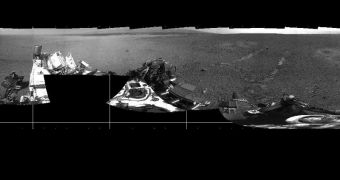A panel of experts comprised of scientists in charge of the Mars Science Laboratory (MSL) rover Curiosity announced yesterday, August 22, that the robot successfully completed its first drive on the surface of the Red Planet.
The maneuver was primarily meant to test the actuators on all wheels, and to see whether the latter can turn a full revolution both forwards and backwards. During the maneuver, the rover often stopped and imaged its wheels, sending the data back to Earth.
Moving the 1-ton, Mini Cooper-sized machine is a tremendous milestone for a mission. During the panel discussion yesterday, California Institute of Technology expert and MSL project manager, Peter C. Theisinger, said that a rover that does not rove would not really be of use to anyone.
Picture stops included, the maneuvers carried out by Curiosity took around 16 minutes. The rover drove a total of 4.5 meters (15 feet) forward. It then stopped, and rotated about 120 degrees on the spot, before finally traveling backwards for about 2.5 meters (8 feet).
Originally, mission controllers at the NASA Jet Propulsion Laboratory (JPL) in Pasadena, California, believed that the drive would take roughly 30 minutes to conclude. The team says that the rover is now 6 meters (20 feet) away from where it first touched down on the Martian surface.
It's interesting to note here that JPL engineers also received current data from all wheels. This is very important for understanding the strain affecting the actuators and motors, and therefore for prolonging Curiosity's operational life.
When the robot touched down, its rear-right wheel landed on a 9-centimeter rock. As it moved forward, engineers were able to determine how such an obstacle impacts the current outflow to the affected wheel, and compare these results with the readings collected from the other wheels.
Also last night, the panel announced that Curiosity's touchdown location would, from now on, be known as Bradbury Landing, in honor of the late author Ray Bradbury (August 22, 1920 – June 5, 2012).
“This was not a difficult choice for the science team. Many of us and millions of other readers were inspired in our lives by stories Ray Bradbury wrote to dream of the possibility of life on Mars,” said Curiosity program scientist, Michael Meyer.
Over the next couple of weeks, the JPL team will continue to perform tests and checkouts of all instruments. Up to this point, with the exception of a REMS wind sensor, everything on the rover is working flawlessly.

 14 DAY TRIAL //
14 DAY TRIAL //